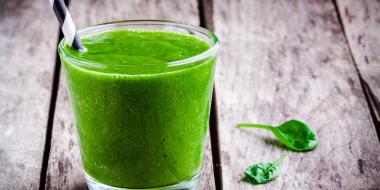Juicing is a method of extracting the liquid from produce and discarding the fibrous pulp. I see it as a sneaky shortcut for eating more raw food than you normally might, making it even easier to consume your recommended daily servings of fresh fruits and veggies. When you have a home juicer, making a fresh blend in the morning is a refreshing way to begin your day and – bonus! – you’ve accomplished a significant healthy eating goal before you even walk out the door. If you have a child going through a picky eating phase, this could be a real solid achievement in tasty liquid form – no small feat! Learn about juicing and how you can do it at home.
The benefits of juicing
The main nutritional benefit is concentrated nutrition. Freshly-made juice allows you to digest and assimilate nutrients very quickly. As there is no fiber to slow the entry of vitamins, minerals and plant phytonutrients (like flavonoids and proanthocyanodins), these compounds get absorbed into your system swiftly.
Juice is great during a diet cleanse. Aside from the powerful influx of nutrients for liver and kidney detoxification, juices give our guts a break. Solid food requires our digestive system to mobilize many enzymes and a number of organs to kick into gear to break down particles into smaller pieces, then eliminate the “junk” through the colon. Drinking juice as a replacement for a regular snack lightens the load. Of course, the fiber which is removed in juicing does have benefits, and it’s retained when we make smoothies, but giving our digestive system even a few hours “off” can allow for some healing, especially if we are experiencing a disturbance like irritable bowel syndrome, food sensitivities or simply an upset stomach or flu.
Smoothies are different in that they are made in a blender so the fiber is whipped in to the mix. Fiber has benefits–making you full for longer, slowing the entry of sugar into the bloodstream, providing bulk, binding toxins and allowing for enhanced elimination of waste. You can also add healthy fats like avocados or nuts and seeds, creamy natural sweeteners like bananas or dates and powders like cocoa or ground flax. You can always combine the two and make a blend where you add fresh juice to your blender and create delicious creamy delights.
Juicing at home
The typical home juicer model is mostly either “centrifugal” or “masticating”. Both of these types of juicers create heat and allow for oxidation, which denatures and degrades the enzymes and nutrients in the liquid quickly, so drink that juice when it is absolutely fresh! Cold-pressed juices retain their nutritional potency as long as 2-3 days after pressing. Cold-pressing uses a hydraulic press with thousands of pounds of pressure to extract the juice at a very rapid speed without heat, thus reducing oxidation and preserving the integrity of nutrients.
If you don’t want to commit to spending a lot of money on a good quality juicer, you can always use a high-speed blender or Vitamix. Just add your chopped vegetables and fruits to your blender with a cup or more of water. Blend on high and then strain through a few layers of cheesecloth, squeezing towards the pulp to get every last delicious drop! You can add leftover pulp to muffin batter or bread dough (carrot or apple go really well here) or use in a savoury “bean burger” or meatball mix (beet, carrot, fennel and greens lend good colour, flavor and texture for binding your mix) or you can add to a smoothie. I have friends who add their pulp to their dogs’ food!
Juicing with kids!
Juices make a power-packed substitute for the after-school snack and creating them together with your kids can be so much fun. Producing delicious elixirs at home is a creative process with instant results. Like cooking and baking (but quicker), this is a great activity for kids – washing, scrubbing, chopping and pushing everything into the machine. You can make this an interesting experiment with colours (rich red of beets, vibrant green of kale and spinach and the bright orange of carrots). It’s an ideal activity to explore “taste training” with all the varied nuances of flavours. If texture is an issue, try a variety of new vegetables that might be less intimidating when juiced. This may allow for an introduction that is later better received when its taste has already been experienced.
Juicing is an enlivening thirst-quenching activity! You can use the recipes below or mix up your own unlimited combinations. These all feature some vegetables and would be considered on the “healthy” end of the spectrum as opposed to a “dessert-treat”. I have not included sweet tropical fruits as I find there is not much effort required to “sell” a sweet juice like watermelon-strawberry or pineapple-peach! However, as it is summertime, by all means experiment with all those fruits you have available in any yummy combinations you and your family can conjure up. Try turning them into popsicles or make cool-shaped ice cubes to add to sparkling water as a kid-friendly, naturally-flavoured summer cocktail treat. Happy juicing!
Orange Fennel Sunrise
Alongside its beautiful warm colour, this is a great digestive tonic, sweet and tart at the same time. Carrots are a key juicing vegetable as they lend their vibrant orange sweetness while also bringing a good dose of beta carotene (vital for eye sight). Celery is refreshing and high in potassium. Fennel adds an anise flavor and is rich in the vitamin ABCs!
- 2 carrots
- ½ bulb fennel (about ½ cup – can include stalk)
- 1 celery stalk
- 1 apple
- 1 orange
- optional: (¼ lemon peel removed)
Red Ginger
A rich immune-boosting elixir that also supports the liver in its grand task of eliminating toxins. Beets are the true earthy powerhouse here, as they help to both cleanse and build the blood. We always appreciate the sweet vitamin C in fresh oranges and the spicy addition of ginger is warming and adds even more immune benefits – start small with the ginger and increase as your kids’ taste buds get accustomed to it.
- 1 small beet
- 3 carrots
- 2 oranges peeled
- ½ inch piece of ginger
Cool Green Cucumber
Cucumber, fresh mint and lime make this a super-cool, refreshing green drink to replenish your electrolytes after a day in the sun. Rich in chlorophyll, vitamins A, C, K and minerals.
- 1 long English or 2 field cucumbers. If organic, leave unpeeled
- 1 pear or granny smith apple
- 2 c chard, spinach or kale
- ¼ lime, peel removed
- ¼ - ½ cup fresh mint









